Singly’s appearance at the startup showcase at Strata 2011 this week has excited thought leaders across the web since the story got out. Singly is a new startup that exists to provide oxygen and commercial support to the open source Locker Project, and new protocol TeleHash.
With some wonderful serendipity I met Singly on my first night at Strata. The next day, I talked in depth to Jeremie Miller and Simon Murtha-Smith, two of the three Singly co-founders (see later in this post). I also had the opportunity to ask Tim O’Reilly, Alistair Croll and Roger Magoulas for some of their thoughts on the significance of this project (see below for their comments).
It was a real – pinch myself in case I need to wake up from a dream experience – for me, to stumble across Jeremie Miller with Simon Murtha-Smith sitting behind a hand written sign demoing Singly at Strata (see my pic opening this post). As Marshall Kirkpatrick notes:
“Jeremie Miller is a revered figure among developers, best known for building XMPP, the open source protocol that powers most of the Instant Messaging apps in the world. Now Miller has raised funds and is building a team that will develop software aimed directly at the future of the web.â€
Singly’s appearance at Strata began auspiciously when they won the judges choice award in the startup showcase. And following Marshall Kirkpatrick’s post, Creator of Instant Messaging Protocol to Launch App Platform for Your Life , and The Locker Project: Why Leave Data Tracking to Others? Do It Yourself, Singly have been burning up Twitter.
Singly, by giving people the ability to do things with their own data, has the potential to change our world. And, as Marshall Kirkpatrick notes, this won’t be the first time Jeremie has done that.
“Pop-cultural instruments for data expression and exploration,†by Bloom
I was drawn over to the Singly table when an awesome app they were demonstrating caught my eye. Fizz, which is running on a locker with data aggregated from three different places is a first glimpse of one of Bloom’s, “pop-cultural instruments for data expression and exploration.â€
Fizz is an intriguing early manifestation of capabilities never seen before on the web – the ability for us to control, aggregate, share and play with our own data streams, and bring together the bits and pieces of our digital selves scattered about the web (for more about Bloom and Singly, see Tim O’Reilly’s comments below). The picture below is my Fizz. In Fizz, large circles represent people and small circles represent their status updates. Bloom says:
“Clicking a circle will reveal its contents. Typing in the search box will highlight matching statuses.
This is an early preview of our work and we’ll be adding more features in the next few weeks. We’d love to hear your feedback and suggestions.â€
If you are not already familiar with The Bloom team, Ben Cerveny, Tom Carden, and Jesper Sparre Andersen – go directly to their about page and you will understand why the match of Bloom and The Locker Project is a cause for great delight.
The Locker Project – a whole new way to connect from the protocol up
As Jeremie began explaining the depth and breadth of what The Locker Project is facilitating, I was utterly gob smacked. And when the penny dropped and I realized this is the whole 9 yards, bringing awesomeness to people with a whole new way to connect, from the protocol up, all I could think was, OMG finally!
Luckily I have had time to catch up with the whole team since then, and recovered my composure enough to ask some coherent questions. But I can still barely contain my enthusiasm for this project.
Singly, The Locker Project and TeleHash take on, and deliver a simple, elegant, and open solution to some of the holy grails of the next generation of networked communications. I have written on, and been nibbling at the edges of some of these grails in various projects myself for quite a while now. Even if you haven’t been reading Ugotrade, just a glance at the monster mash of my pre Strata post will give you an idea of how important I think Singly is.
My previous post raised the question of how to invert the search pyramid and to transform search into a social, democratic act. But if you are really interested in social search, I suggest staying keyed into what Singly is doing with The Locker Project!
One of Singly’s three founders, Simon Murtha-Smith, was building a company called Introspectr, a social aggregator and search product. Singly’s other founder Jason Cavnar was working on another similar project. And they came together as Singly because social aggregation and search is a very hard problem for one company to solve, and they realized that the basic infrastructure needs to be open source and built on an open protocol.
As Jeremie puts it, “We shouldn’t…(every startup that wants to do something interesting) have to spend this much time aggregating the data, building robust aggregators.â€
To me what is so important about the Locker Project is that it is built on a new open protocol, TeleHash. And having the Singly team focused on supplying tools and the trust/security layer for the Locker Project will mean that developers have the whole stack they need to do some interesting stuff very soon.
I asked Jeremy to explain the relationship between TeleHash, The Locker Project and Singly.
Tish Shute: So TeleHash…
Jeremie Miller: It’s a peer-to-peer protocol to move bits of data for applications around. Not file sharing, but it’s for actual applications to find each other and connect. So if you had an app and I had an app, whenever we’re running that app on our devices, we can actually find those other devices from each other and then connect. Our applications can connect and do something.
For the entire edge of the network, basically, out there in the wild, and let those things mesh together.
And TeleHash is actually what has led to the Locker project itself.
Tish Shute: So TeleHash led to the The Locker Project and the Locker Project led to Singly?
Jeremie Miller: Singly is a company who is sponsoring the open source Locker Project…the three of us as founders, [left to right in pic below - Jeremie Miller, Jason Cavnar, Simon Murtha-Smith, ]
I took the pic above of all three founders being interviewed by Marshall Kirkpatrick of Read Write Web for his post, “Creator of Instant Messaging Protocol to Launch App Platform for Your Life.“ I think we will look back on this moment and say it was an inflection point for the web. At least I tweeted that!
Jeremie Miller: TeleHash is a protocol that lets the lockers connect with each other and share things. The locker is like all of your data. So it’s sort of like a digital person…
Tish Shute: A locker for bits and pieces your digital self?
Jeremie Miller: Yes. So TeleHash lets the lockers connect and directly peer-to-peer connect with each other and share things. Singly, as a company, is going to be hosting lockers first and foremost. But the Locker Project is an open source project. You can have a locker in your machine or you can install it wherever you want…
Tish Shute: Yes it’s often too difficult for a lot of people to set up something locally…so Singly makes it easy to have a locker right?
Jeremie Miller: A lot of people see this cool app or this cool thing they want to do, it’s something that you run in your locker that they need to be able to turn on a locker somewhere very easily.
Tish Shute: So Singly will provide the trust layer and hosting?
Jeremie Miller: Yeah, Singly is a company that will host lockers, as well as…when people build applications that run inside your lockers or use your data, you need to be able to trust them. Maybe it’s like social data and you don’t care that much. But especially once you start to get any of your transactions in there, your browsing history, your health data, like your running logs or sleeping…fit-bit stuff…then it’s much more important to be careful about what you’re running inside your locker and sharing.
So Singly will also look at the applications that are available that you can install and actually run them and look at what data they access, and look at who created them, and be able to come back and either certify or vouch for them.
And I hope in the long-run, as this grows and builds, that power users may actually be able to buy a little device that they can plug into their home network that is their locker. Wouldn’t that be cool? This little hard drive or whatever that you plug in.
Tish Shute: Wow – that would be very cool! Architecturally is TeleHash and the Locker Project related to your work on XMPP?
Jeremie Miller: Architecturally, some of the stuff I’ve learned, XMPP, in Jabber it was designed for the specific purpose of instant messaging, but it was still a federated model, in that you still had to go through sort of a central point so you could…a server that lived somewhere. So it was really optimized for like businesses and small groups, teams, as well as big companies out there; ISPs can use it.
So it was designed with that in mind—for the communication path to be routed through somewhere. And where I’ve sort of evolved over the years since then is really fascinated with truly distributed protocols that are completely sort of decentralized so that things are going peer-to-peer instead of actually through any server.
The last 10 years, peer-to-peer has gotten a pretty bad rap with file sharing.
Tish Shute: A really bad rap, yes.
Jeremie Miller: Yeah. And almost because of that, and because it’s really hard to do, that it hasn’t gotten…the potential for it’s awesome. There’s so many really good things that can be done peer-to-peer. And it hasn’t gotten used very much.
But the other side of the peer-to-peer thing that I think is critically important, look at the explosion of the computing devices around a person anymore, both in the home and on our person. We have one, two, three, four even. And the number of devices that are online for you that are yours…I look at my home network router and I’ve got 30 devices in my house on Wi-Fi. What the heck? That’s a lot of devices.
But right now, all of those devices, for me to work with them, I’m almost always going through a server somewhere, through a data center somewhere, which is ridiculous at face value. You go five, 10 years out from now, there’s probably going to be 300 devices on me in some form.
Tish Shute: So we need a peer-to-peer network just to manage our own devices?
Jeremie Miller: A peer-to-peer, yes. You know, my phone should be talking straight to my computer, or to the iPad, or to the washing machine, or refrigerator. The applications in my TV, or whatever, they should all be talking peer-to-peer. And it should be easy to do that. It shouldn’t be that the only way you can do that is to go through a data center somewhere.
[Our conversation continued, but to sum things up, for now, here is the final question I asked Jeremie which pretty much packs in everything I would like to do with TeleHash, the Locker project, and Singly tools/trust layer all in one!]
Tish Shute: How can TeleHash, the Locker, and Singly help people combine personal data from different sources – web and mobile for example, so the data locked up in our social graph on the web can be integrated with, for example, the location data and “the data wake†from our cell phone sensors, to know not only where we have been but to give us more ways to know where we are going?
Jeremie Miller: That’s a pretty packed question, but here’s my simple answer, hopefully just seeds the right discussion ![]()
Telehash is the protocol that lets the apps (mobile, sensor, or anywhere) talk to a locker as well as lockers talk to each other, it’s the chatter, moving the bits around the network. The locker is the storage for a person’s data and the crunching ability to analyze it or trigger actions from it. Singly is the company sponsoring the project(s) and helping anyone dev apps atop it. We’re going to build the platform and looking to the world to create some amazing things on top of it (we have lots of our own personal ideas we already want to create, hah!).
The Locker Project is not just “one more rebel army trying to undo these big data aggregations,” Tim O’Reilly
@lockerproject: “We’ll be posting updates on the Locker Project (https://github.com/quartzjer/Locker) here as we make progress, very awesome stuff “
During the Strata Media Conversation I asked Roger Magoulas about Singly and The Locker Project because Roger played Yentl and brought Singly and Bloom together! Although there was not much time to discuss it, the relationship of TeleHash, The Locker project and Singly to the social network encumbents, came up, and Roger Magoulis and Tim O’Reilly gave some very insightful comments on this when I talked to them afterwards (see below).
Roger Magoulas pointed out:
“I think Singly has Facebook like aspects, but I think a better description is an app platform that integrates your personal and social network data – including data from Facebook. Sing.ly is likely to have challenges with some of their data sources, particularly if Sing.ly gains traction with users.
I like the app platform business model, although they face risks getting critical mass and app developer attention, and I like how they plan on using open source connectors to keep up with changing social network platforms. Jeremie has credibility with the open source community and is likely to find cooperating developers. The team seems to bring complementary strengths to the project and you can tell they all work well together. â€
And Tim O’Reilly went on to elaborate the awesome potential of this platform to bring something new to the ecosystem, and to comment on just how interesting Bloom’s insight into, “data visualization as a means of input and control” is.
Talking with Tim O’Reilly
Tish Shute: So will the Locker Project be able to break the lock of Facebook’s and other big sites’ control of everyone’s data. Sometimes I feel we are stuck in the era of Zyngification, where you have to do what Zynga did and leverage the system in order to gain traction or do anything with social data?
Tim O’Reilly: I don’t think that is the objective of the Locker Project —to break the Facebook lock, because I tend to agree, the value of Facebook is having your data there with other people’s data. What Singly may be able to accomplish is to give people better tools for managing their data. Because if you can actually start to abstract the data from various sites and you can set it and manage it yourself, then you can potentially make better decisions about what you’re going to allow and not allow. Because right now, the interfaces on a lot of these sites make it very, very difficult to understand exactly what the implications are.
And I think all this done right will create a marketplace where people will build better interfaces that will give people more control over their data. They’ll still want to put it on those sites, because why do you put your money in the bank? You know, because it’s more valuable being with other people’s money.
And I think that to conceive of it as one more rebel army trying to undo these big data aggregations is just the wrong way to frame it.
Tish Shute: Yes and framing the question the way you just did – that this is not just one more rebel army, might mean that the stage at Strata will be filled with new startups next year! That’s what I thought when I found out what The Locker Project and Singly was about – that we are about to see an explosion of creativity with personal and social data.
Tim O’Reilly: Yeah, sure. I mean, because at the end of the day, if you can start to extract your personal data in ways that make it more useful, you can potentially create the ability for people to build better interfaces. It’s not just Facebook.
You know, you think, “Oh, wow, I’d really like to have a management console for all my contacts.†And you go, “Well, I’m stuck with, I can use Facebook, I can use LinkedIn, I can use my address book in Outlook or Gmail or whatever, or on my local machine.†The tools are pretty primitive. And if we get a better set of tools, I think we’ll see a lot of innovation.
Now, some of those startups might well be acquired by a Facebook or a Google. But it if moves the ball forward in giving people better visibility and control over their data, that’s a good thing.
Bloom’s insight, “data visualization will become a means of input and control.”
Tish Shute: I loved the marriage with Bloom, which is interesting, because Ben and the Bloom team haven’t really talked a lot about Bloom yet, but I gather Bloom is moving to consumer facing work with data?
Tim O’Reilly: What’s really interesting about Bloom is the notion…You know people think of data visualization as output. And the insight that I think Ben has had with Bloom is that data visualization will become a means of input and control.
Tish Shute: Right, very cool.
Tim O’Reilly: So I’ve started to feel like data visualization as a way of making sense of complex data is kind of a dead-end. Because what you really want to do is to build these feedback loops where you actually figure something out, some particular atomic action well enough that you can create an application that let’s somebody actually do something with it. But the idea of visualization as a way of manipulating the data in real-time, data visualization as interface rather than as a report, it’s a small but subtle shift that I think becomes kinda cool.
Talking with Alistair Croll
Sing.ly – Join or Die from Singly Inc on Vimeo.
Alistair Croll: So I’m a big fan of Singly. They were my choice for the Startup Showcase. I think it’s certainly the right time – the team can execute on it. But the thing I like the most is I thought back to the early days of Photoshop.
So, Photoshop was a neat application that could take data in the form of an image and manipulate it. But the real value from Photoshop came from these amazing plugins. Like, there’s a company called Kai’s Power Tools that made these things that would allow you to do manipulations. Today, commonplace things that are built in. But at the time, they were things like building bubbles, and spheres, and drop shadows and stuff like that, cutouts, in amazing ways.
Another company, I think, called Alien Skin that made these things. There’s whole ecosystems of plugins. So you could go and get a plugin and transform that original data in ways you hadn’t thought of. And eventually, there was a macro language for scripting how you could do those things, and that found its way into the Photoshop environment.
But you think about the transformation of digital design from Photoshop, I think if you can take that same pattern of you create the basic ecosystem of a few tools, and then you allow people an open system on top of that, that’s unprecedented. I think it really does allow you to take ownership of that.
And then when you allow people the proper tools to federate that information. I was actually thinking of starting a company a couple of years ago based on data federation like that. But what you really want to say is I’ve got a pattern…It’s almost like a multi-channel mixer. You’ve got a band that is your health, your weight, your blood pressure, family photos, words you’ve used. You know, the more data I record when I carry my phone around with a headset of whatever, all of that stuff goes in, all my searches, everything.
And then I say, “Ah, I want to federate height, weight, and blood pressure with my doctor. I want to federate sleep cycles and nutrition with my child’s teacher,†and so on and so on. And you start to create these federated sources of data where now you have a teacher data mining, in a safe manner, the sleep and health habits of all the students along with report card information. And you suddenly realize that Johnny is borderline diabetic and falls asleep at recess.
That’s something that never would have happened. And that happens when you have tools to federate data and then compute on top of them. So this idea of, like, lifestreaming or life logging, this is a logical consequence of the whole lifestreaming movement; that whole recorded future stuff.
Tish Shute: Yes it really is a wonderful fruition to the visions of the lifestreaming movement [see this interview with David Galernter]. And best of all it sits on a new open protocol, TeleHash and the open source Locker Project that will give tools to everyone to work with these data streams.
Alistair Croll: Exactly. This is the toolset that sits on top of that stuff. Because once I’ve life-streamed everything, great, I have this bucket of stuff that I did that I never look at again. But if I can suddenly unlock that with data mining tools and analyze patterns, all of a sudden that life logging has a reason to have existed.
The biggest problem we have with data right now is we don’t have apriori knowledge of what will be useful. We could have been recording crime reports in the city of Chicago, and a year later it turns out that data is really useful for predicting diabetes in the city, but we didn’t know it was related.
So the problem, and one of the things I think that distinguishes big data from traditional data, traditional data is collected to some apriori knowledge of how it will be used. Big data tends to be collected for the sake of…it’s almost collected on faith that later on it will be useful for something.
Tish Shute: I am very interested in this idea of federation, I actually went as far as to deep dive into Wave servers because of this….
Alistair Croll: Yeah, Wave was a great example of federation, just too complicated. When it was canceled, both users [and developers] were furious.
Tish Shute: Yeah, I suppose you could see Google Wave as a bit of an Icarus project, right? I am so excited by Singly because it is coming sort of bottom-up – a very different approach…
Alistair Croll: And remember, Facebook didn’t work before Friendster. The only difference between being wrong and being too early is that too early costs a lot of money. So it may be that this is an idea that works now, but a couple years ago didn’t work.
Alistair Croll, co-chair of Strata 2011, in his post, reframed the question, “Who Owns Your Data?†as, “It’s not who owns the data, it’s about who can put the data to work.â€
And I am sure there will be many more people able to put data to work, and into play, in a multitude of interesting ways, now we have TeleHash, the Locker Project, and Singly.
Photo by Duncan Davidson.
Strata 2011 is presented by O’Reilly Media. Produced by Good Company Communications.
I think the photo above gives a good idea of how I felt on the last day at the Strata conference. Yup – like the cat who got the cream!
And in case you are wondering where AR is in this story – it is everywhere! Below is a pic of the AR concept designs that were omnipresent in the media communications at Strata. The one below I snapped off the job board. But as Sophia Parafina noted, “AR is maturing from displaying last year’s text bubbles and dinosaurs to big data overlaid on the world.”

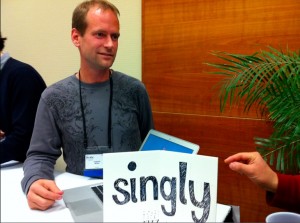
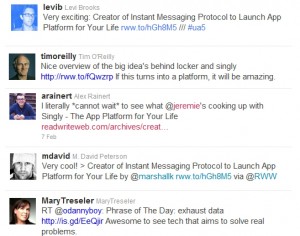
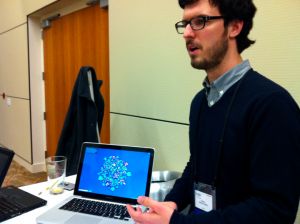
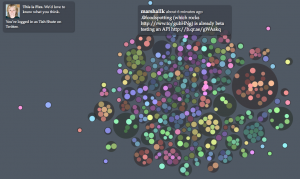

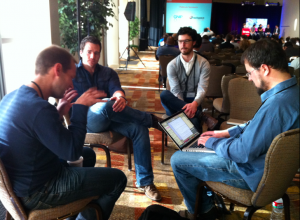




February 12th, 2011 at 6:50 pm
Great interview and it really sounds like an interesting project.
The P2P principle is great, and its very true that P2P technology is still relatively underused.
I would have liked more interest in future plans or how they see things progressing.
At the moment it sounds great for collecting your data in realtime and examining it in all sorts of interesting ways.
However, a lot of questions remain in my mind how to share that data out, and how to share it out selectively. Thats what the Wave Federation Protocol seemed to handle really well, if the same possibilitys could allow a Collection in a Locker* to be shared selectively with your friends (preferably with editing permissions) you could get something like Wave much easier to implement.
Of course, this is a hard task. But it would be great to hear if this is possible down the road, and if so how far.
–
*hope my terminology is right!